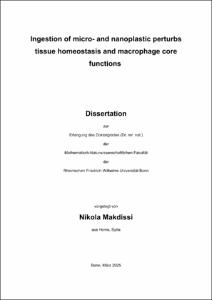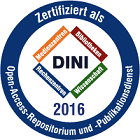Makdissi, Nikola: Ingestion of micro- and nanoplastic perturbs tissue homeostasis and macrophage core functions. - Bonn, 2025. - Dissertation, Rheinische Friedrich-Wilhelms-Universität Bonn.
Online-Ausgabe in bonndoc: https://nbn-resolving.org/urn:nbn:de:hbz:5-86258
Online-Ausgabe in bonndoc: https://nbn-resolving.org/urn:nbn:de:hbz:5-86258
@phdthesis{handle:20.500.11811/13659,
urn: https://nbn-resolving.org/urn:nbn:de:hbz:5-86258,
author = {{Nikola Makdissi}},
title = {Ingestion of micro- and nanoplastic perturbs tissue homeostasis and macrophage core functions},
school = {Rheinische Friedrich-Wilhelms-Universität Bonn},
year = 2025,
month = nov,
note = {Plastic pollution has emerged as a global environmental crisis of unprecedented scale. Micro- and nanoplastic (MNP) pervade ecosystems, resulting in persistent exposure for all living organisms, including humans. MNP have been detected in human blood. Additionally, animal studies indicate MNP ability to cross biological barriers and accumulate in organs such as the liver, spleen, and brain. Nevertheless, the impact of plastic accumulation on tissue homeostasis and immune cell function remains poorly understood. This study investigates the consequences of chronic polystyrene particle ingestion using a mouse model.
Following oral ingestion, MNP breach tissue barriers and accumulate in multiple organs. Hepatic and splenic macrophages are pivotal in the uptake and retention of MNP, leading to their long-term persistence in these tissues. This prolonged presence disrupts metabolic homeostasis in the liver and adipose tissues without inducing systemic inflammation. Moreover, MNP ingestion exacerbates metabolic dysregulation under additional stress, such as a high-fat diet, worsening glucose intolerance.
On a cellular level, MNP accumulation in Kupffer cells, the liver-resident macrophages, impairs their phagocytic function, reducing their ability to clear circulating bacteria. Additionally, MNP-exposed mice exhibit signs of an autoimmune phenotype.
Altogether, our results demonstrate the hazardous nature of MNP ingestion on tissue homeostasis, metabolism, and macrophage functionality. These findings suggest that chronic exposure to plastic particles could contribute to the rising prevalence of environmentally linked metabolic and autoimmune diseases.},
url = {https://hdl.handle.net/20.500.11811/13659}
}
urn: https://nbn-resolving.org/urn:nbn:de:hbz:5-86258,
author = {{Nikola Makdissi}},
title = {Ingestion of micro- and nanoplastic perturbs tissue homeostasis and macrophage core functions},
school = {Rheinische Friedrich-Wilhelms-Universität Bonn},
year = 2025,
month = nov,
note = {Plastic pollution has emerged as a global environmental crisis of unprecedented scale. Micro- and nanoplastic (MNP) pervade ecosystems, resulting in persistent exposure for all living organisms, including humans. MNP have been detected in human blood. Additionally, animal studies indicate MNP ability to cross biological barriers and accumulate in organs such as the liver, spleen, and brain. Nevertheless, the impact of plastic accumulation on tissue homeostasis and immune cell function remains poorly understood. This study investigates the consequences of chronic polystyrene particle ingestion using a mouse model.
Following oral ingestion, MNP breach tissue barriers and accumulate in multiple organs. Hepatic and splenic macrophages are pivotal in the uptake and retention of MNP, leading to their long-term persistence in these tissues. This prolonged presence disrupts metabolic homeostasis in the liver and adipose tissues without inducing systemic inflammation. Moreover, MNP ingestion exacerbates metabolic dysregulation under additional stress, such as a high-fat diet, worsening glucose intolerance.
On a cellular level, MNP accumulation in Kupffer cells, the liver-resident macrophages, impairs their phagocytic function, reducing their ability to clear circulating bacteria. Additionally, MNP-exposed mice exhibit signs of an autoimmune phenotype.
Altogether, our results demonstrate the hazardous nature of MNP ingestion on tissue homeostasis, metabolism, and macrophage functionality. These findings suggest that chronic exposure to plastic particles could contribute to the rising prevalence of environmentally linked metabolic and autoimmune diseases.},
url = {https://hdl.handle.net/20.500.11811/13659}
}






